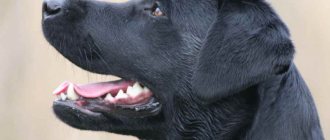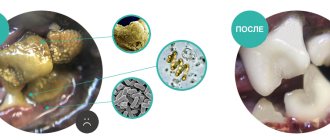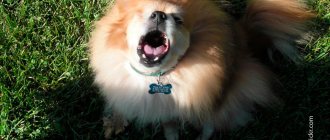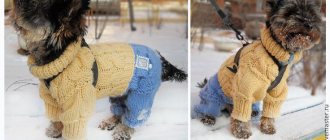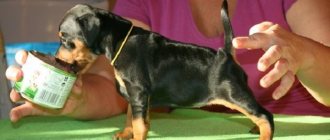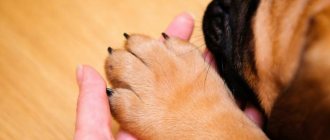Tartar in dogs is a fairly common phenomenon. Often, dog owners, having discovered a small yellow coating on their pet’s teeth, do not attach much importance to it. In fact, the appearance of tartar is a fairly serious problem that can lead not only to tooth loss, but also to sepsis, often leading to the death of the animal.
So what is tartar in dogs? Why does it form and how to deal with it? Let's talk about this in detail.
Why do dogs develop tartar?
The basis for the formation of tartar in dogs, as in humans, is the mineralization of soft plaque.
The latter is formed from rotted food debris, bacteria, salts and other components. Gradually, the plaque hardens and is firmly attached to the enamel. Most often, tartar develops in areas that cannot clean themselves, for example, between teeth, at the root collar, and others. The growths can affect several teeth at the same time, be located both near the gum and under it, have different thicknesses and shades of yellow or brown.
There are mainly several factors that lead to the appearance of tartar in dogs.
- Errors in choosing food. Soft food (including dry food) does not contribute to prolonged friction of dental surfaces against each other, which leads to plaque deposition.
- Excess carbohydrates in your pet's diet. If the owners often pamper their pet with “delicious” foods, sooner or later he will develop stones on his teeth. This is due to the increased proliferation of bacteria in the oral cavity.
- Diseases of the digestive tract. Some gastrointestinal diseases contribute to the development of heartburn, changes in the pH of the stomach, as well as the dog’s oral cavity. The pH shift leads to the formation of stones.
- Changes in the structure of the jaw (long, narrow, pathologically changed), malocclusion, narrow spaces between teeth and others. Incorrect placement of teeth in a row leads to insufficient self-cleaning.
- Age. In older animals, due to age-related metabolic changes, the process of hardening of soft plaque occurs faster.
Note: dog breeds such as dachshund, chihuahua, Pekingese and the like are at risk. For the condition of their teeth, prevention of tartar is important in the first place.
Before and after dental tartar removal in dogs
What is tartar and how to find out about its appearance
The beginning of the formation of tartar is the formation of a soft plaque on the enamel. It consists of food debris, bacteria and mucus, which glues it all together into a solid mass. Gradually, this substance mineralizes, and after about 4-6 months, hard tartar appears.
It is very easy to find out about his education. The first thing the owner begins to notice is an unpleasant odor from the pet’s mouth.
During the examination, plaque can be seen at the base of the teeth, which at first has a pale yellow color. The formations are soft and loose. But over time, it mineralizes and hardens, and the color becomes dark brown or almost black.
Tartar forms on those parts of the tooth that do not have direct contact with food or toys: on the front of the teeth or at their very base.
Symptoms of Tartar
Of course, the main symptom of stone deposits on a dog’s teeth is their immediate detection. However, not in all cases this can be done visually and at home. In addition, not every owner will examine all of their pet’s teeth daily for the presence of stones, so you should pay attention to the accompanying signs of the development of dental growths:
- rotting odor from the mouth;
- swelling, redness of the gums, the appearance of traces of blood on pieces of food;
- refusal to eat (due to pain in the gum tissues).
If at least one of them is present, the animal should be taken to a veterinarian.
Symptoms of the disease
The formation of plaque occurs unnoticed - at least if you do not look into the dog's mouth regularly. The thickening of plaque and an increase in its hardness occurs asymptomatically. Only when the disease becomes advanced do the first signs appear. The main symptoms include:
- bad breath;
- the presence of yellowish (at the initial stage) or dark (in more advanced cases) plaque, which is observed at the base of the incisors, canines, and molars;
- gums become inflamed, gingivitis or stomatitis appears;
- in the most severe cases, the gums acquire a loose structure and begin to bleed; The dog often scratches the inflammation areas and refuses food.
Sometimes a severe form of tartar is accompanied by profuse salivation, lethargy, or, on the contrary, increased aggressiveness of the animal.
If the dog begins to slurp unusually while eating, licks itself frequently, and scratches the area around its mouth, it’s time to conduct an initial examination.
What danger does dental plaque pose to animals?
Tartar tends to build up, so it gradually puts more and more pressure on the surrounding soft tissue. In addition, by pushing the gum away from the tooth, the growth can eventually reach the root, which will require serious intervention.
Possible complications of dental stones in dogs include:
- caries under a stone;
- stomatitis;
- gingivitis;
- tooth loss;
- malocclusion;
- sepsis;
- digestive problems;
- diseases of the gastrointestinal tract.
The constant release of toxins by multiplying bacteria leads to severe intoxication of the pet’s body. This, in turn, greatly weakens the immune system and promotes the addition of other infections. In especially severe cases, the matter may end in the death of the animal.
Tartar formation and consequences
Reasons for the problem
Stone plaques form in hard-to-reach places under unfavorable conditions and lack of hygiene. There are several factors that can cause tartar to appear on a dog’s teeth.
Incorrect selection of feed
The risk of plaque increases significantly if the pet is fed soft food. It does not contribute to prolonged friction of the jaw surfaces and self-cleaning of the teeth. Constantly feeding an animal canned food is the main mistake of modern breeders. It should be remembered that the dog’s teeth need active use. If you stop using the incisors, canines, and molars, the jaw will begin to deteriorate.
Dry food partly solves the problem, since solid particles clean off the initial plaque. But this does not mean at all that dogs consuming “drying” are protected from the formation of tartar.
Impaired metabolism
Excessive carbohydrate content in food leads to a weakening of the body's protective functions. You shouldn’t spoil your furry friend with “tasty food.” Experienced breeders know that sweets are contraindicated for animals - they contribute to the development of diabetes and oral problems. This is due to the accelerated proliferation of bacteria: plaque will appear faster and darken if the dog’s diet is not balanced.
High acidity of saliva
This indicator is individual: everything will depend on the breed, age, gender and other characteristics of the dog’s body. Acidic saliva is a favorable environment for some bacteria; it can become a factor in disrupting salt metabolism. Veterinarians believe that frequent hypothermia and insufficient physical activity can lead to such a deviation.
Late mouth care
Not only people should constantly brush their teeth; pets also need a similar procedure. Even if you feed your dog the highest quality products, over time he will develop deposits in any case. To avoid problems, you should periodically clean the mouth with veterinary paste and give the animal bones specially designed for this.
Irregular teeth structure
Predispositions to the formation of stones include pathological changes in the jaw, malocclusion, narrow interdental spaces, too dense or crooked teeth. All this leads not only to plaque, but also to digestive problems.
Of course, the stone itself does not pose an immediate threat to life. But against the background of enamel damage, diseases can develop, for example, gingivitis, periodontal disease, gastrointestinal disorders, and respiratory problems. And these problems can subsequently lead to the death of the pet.
Untreated tartar weakens the immune system, which inevitably leads to diseases of all kinds. Therefore, caring for a dog’s teeth should be perceived by the owner as an important part of keeping a pet.
Cleaning dental plaque in dogs in the clinic
You can have your four-legged friend's teeth cleaned at any veterinary clinic. Before the procedure, the specialist will examine the dog’s oral cavity, assessing the condition of not only the teeth, but also the soft tissues for the presence of inflammatory processes. In some cases, you will need to undergo a laboratory examination - donate blood. An X-ray examination may be necessary if stone deposits are poorly visible, or there is a need for additional examination of the tooth root or jaw. If the cleansing is planned to be carried out under anesthesia, then the list of preparatory measures will necessarily include an ECG.
How does the procedure work?
Removing tartar from dogs in the clinic
In general terms, dental plaque removal in dogs follows the following algorithm:
- carry out antiseptic treatment of the oral cavity;
- remove the stone;
- disinfect the treated surface.
If necessary, teeth are ground, polished, and fluoridated.
It should be noted that the specialist’s actions depend on the degree of the detected pathology, as well as on the characteristics of the four-legged patient. For example, with a small growth, it is possible to use a mechanical method of cleansing using special devices or ultrasonic (at the owner’s choice). If the tartar is of impressive size, then it is first filed down mechanically, and then ultrasound can be used. Or the specialist chooses a different combination.
Without anesthesia, it is possible to remove dental plaque in small dogs that are calm about the procedure, as well as in cases where the teeth only need to be “renewed.” If the problem is serious and requires several manipulations, or when the four-legged patient is of impressive size and has an unstable psyche, then general anesthesia is used to remove the stone.
What is tartar on dogs' teeth?
Solid compounds of food particles and microorganisms, impregnated with minerals, can form unnoticed over four to six months. Initially, you can see a thin film, which contains microbes and their waste products. If you do not take care of your dog’s mouth and do not monitor your pet’s hygiene, then the food debris will begin to layer on top of each other, the plaque will thicken, and as a result, a stone plaque will appear.
Plaque quickly spreads throughout the oral cavity, affecting the enamel of closely spaced teeth. Darkening occurs gradually, changing over time from yellow to brown.
Seals can be located above the gum and below the gum. In the first case, the problem can be easily noticed by the owner himself during regular inspection. This option is less dangerous, since it can be easily removed without damaging the enamel.
The second option is characterized by greater hardness and a darker shade. In this case, the stone is fixed between the root and the alveolus, so it is not easy to eliminate. First of all, the fangs and incisors are affected, and then the disease spreads to the entire jaw.
At first, the stone formations do not cause any inconvenience to the animal, but as they accumulate, the first alarm bells appear. It is important to regularly examine your dog's mouth, brush his teeth thoroughly, and visit a canine dentist once a year.
How to remove dental plaque from dogs at home
You can remove dental plaque from your pet yourself at home. The animal should be accustomed to such procedures from puppyhood - in this case, the dog will respond adequately to cleaning, and the time spent on the process will be minimal. To clean teeth at home, two methods are used: chemical and mechanical.
Chemical removal
For the chemical removal of tartar in dogs, various compositions are used, the mechanism of action of which is based on the dissolution of deposits. Such products are available in several forms.
- Elixir (solution). A gauze swab is soaked in it and placed on the animal’s tooth. To achieve results, the tampon must be held in one place for several minutes (according to the instructions). At the end of the procedure, the teeth are wiped with a clean cloth. An example of such a tool is Xident.
- Gel. There is no need to hold gel preparations on the surface of the teeth, which greatly facilitates the process of removing tartar. After applying a certain amount of gel to the surface of the enamel, its active components are mixed with the animal’s saliva and applied to all units of the dentition. After some time (specified in the instructions), softened deposits can be easily removed using the usual mechanical methods, including with a brush. An example of such a product is Tropiclean gel.
- Spray. It is also easily applied to the surface of the teeth, where it has a splitting effect on hard plaque within an hour. Experts recommend not to feed or water the animal during this period. After the spray wears off, you can brush your dog’s teeth mechanically.
Mechanical removal
Dental scaler
The mechanical method of removing tartar most often involves the use of a special dental device - a scaler. It looks like a small handle with a spatula or scraper at the end. The use of scalpels and other objects is highly discouraged, as there is a possibility of injuring the dog’s gums. In some cases, they resort to using a hard brush, but this is only justified when the stone is small in size and has been previously softened with a chemical.
Attention: using a scaler at home requires preliminary preparation - you will need cotton-gauze swabs, hydrogen peroxide (for antiseptic teeth before cleaning) and Lugol's solution (for treating gums after the procedure).
How to brush your dog's teeth.
We all know that any disease is easier to prevent than to treat later. This also applies to tartar. In order not to worry in the future about how to remove/remove plaque on your teeth, you need to take preventative measures, which include basic brushing of your teeth at home.
What is the best way to brush your dog's teeth?
Cleaning the fangs and incisors from plaque is carried out with a regular toothbrush, but with a special dog paste.
Pastes that are produced for use by people are absolutely not suitable for dogs. They contain sodium sulfate, which when applied begins to turn into foam, which causes dissatisfaction in animals.
Therefore, special non-foaming pastes have been developed for dogs that the animal can swallow. And nothing will happen to the pet.
White plaque on a dog's teeth cannot be cleaned off.
When dog paste fails to remove white plaque, you can use a homemade mixture of regular tooth powder and a 3% hydrogen peroxide solution.
Apply the mixture to whatever you are going to use to clean plaque on your teeth (brush, gauze, cotton pad) and go over the fangs and incisors of your four-legged friend.
How can you brush your dog's teeth if there is no toothpaste?
If there is no paste, then plaque can be removed from fangs and incisors using products that cleanse the animal’s oral cavity and freshen breath. For example,
- chewable bars/tablets for cleaning teeth;
- a treat that supports oral health;
- menthol tablets;
- spray for cleaning fangs and incisors.
All these special products are sold in veterinary pharmacies.
In addition, pet stores offer a wide range of rubber toys, which, in addition to pleasing the dog, also clean the teeth and massage the gums.
Externally, such toys are distinguished by the fact that they are covered with small teeth.
When is the best time to contact a veterinarian?
Although there are enough products on sale to rid your dog of tartar, in case of large deposits, and also for the first time, it is better to consult a veterinarian. Removing stones on your own risks infection entering the tooth cavity (especially in the presence of a carious process), damage to the gums, and inflammation of the soft tissues and oral cavity. In addition, the animal may suddenly jerk and get injured. And finally, the specialist will not only properly clean your pet’s teeth, but will also carry out sanitation, ensure that the results are consolidated, and give recommendations for further care.
The benefits of an irrigator when caring for zirconium crowns
The irrigator is ideal for caring for zirconium crowns and dental structures. The operating principle of the irrigator is based on a directed pulse of water with adjustable intensity. Such equipment massages the gums and effectively cleans the interdental space. Unlike dental floss, it is impossible to damage soft tissues with an irrigator; there is absolutely no discomfort during such treatment.
You can purchase the irrigator in a stationary or portable version. The second option is slightly inferior in terms of water capacity, but you can take the device with you and care for your oral cavity while traveling.
Author of the article
Which method of removing tartar is better?
It is impossible to say unequivocally which method of removing deposits from a dog’s teeth is better. Each of them has pros and cons. Thus, the price of mechanical cleaning at home and even in a clinic will be much lower than an ultrasound procedure. However, such removal spoils the enamel, which can subsequently lead to the development of caries and other pathological processes.
Today, most experts recommend ultrasonic removal of dental plaque. Among its advantages:
- minimal risk of tissue trauma;
- no pain;
- high efficiency;
- requires less time.
The only disadvantage of ultrasound is its relatively high cost.
What is the danger?
Tartar does not disappear on its own; it must be removed at home or by a veterinarian. Otherwise, the growths lead to a wide variety of diseases, and they, in turn, threaten the health and life of the pet. What to watch out for:
- tooth decay and subsequent abscesses (suppuration);
- digestive problems;
- exhaustion of the dog - due to unpleasant sensations while eating, it stops eating properly;
- respiratory tract diseases.
Sometimes the rapid formation of plaque and stone may indicate that the dog is experiencing negative changes in its body. In this case, urgent diagnosis and timely treatment are required.
Prevention of tartar formation in dogs
Cleaning your dog's teeth at home
You can prevent the formation of tartar in your four-legged friend by following certain rules.
- Bones must be included in the animal's food. It is important that they are beef, but not splintered (so-called moss), preferably containing cartilage tissue.
- You should avoid feeding your dog sweet treats, overly nutritious formulas, or canned foods.
- It is worth monitoring the condition of your pet’s gastrointestinal tract.
- From puppyhood, you need to use a special brush and toothpaste to clean your dog’s teeth.
- Periodically wipe your pet's teeth with a piece of gauze soaked in a soda solution.
- Visit a veterinarian once every six months for examination and sanitation of the oral cavity.
Such measures are quite enough to ensure that your four-legged friend’s smile is always perfect and his teeth are healthy.
Prevention measures
To ensure that your pet’s teeth are always healthy and that you do not have to resort to surgical intervention due to the formation of tartar, it is necessary to regularly monitor your pet’s oral hygiene and carry out preventive measures.
Take care of proper nutrition for your four-legged
Tartar in dogs is partially removed when the animal eats solid food that requires thorough chewing: carrots, apples, cartilage, trachea and bones. But remember that not all bones can be given to your pet. To learn about which bones you can give to your beloved furry friend and which you absolutely cannot, read the article: Can dogs have bones?
Brush your pet's teeth regularly
Regular brushing and special toothpaste for dogs will help keep your pet's teeth healthy for many, many years.
It is not necessary to brush your dog's teeth every day. Preventative cleaning once a week is sufficient. Accustom your little one to this procedure from puppyhood. The sooner he gets used to this, the easier it will be for you to brush his teeth as an adult. Even if your baby hasn’t yet lost his baby teeth, just wrap a bandage around your finger and slowly rub them on your puppy.
Use special products to clean the animal's mouth and freshen its breath.
For example, Oral Clean & Care gels and sprays (trademark “Platinum”) will cope with this task perfectly. They are intended for treating the oral cavity of not only dogs, but also cats, and are made from natural-based ingredients. You can read about this in detail here – https://myplatinum.ru/service/advantages/platinum_zabotitsya_o_polosti_rta_vashego_lyubimtsa/. You can also order online there.
According to a representative of the manufacturer, their hygiene products will not only help eliminate the unpleasant odor emanating from the dog’s mouth. Moreover, it is now possible to remove tartar from your pet without the use of anesthesia, outside the walls of a veterinary clinic! Many questions regarding the use of hygiene sprays and gels will disappear by themselves if you go to this page - https://myplatinum.ru/service/questions/.
In my opinion, the results after using Oral Clean & Care are quite impressive.
How do you like this? In just two weeks.
Excellent result.
Pet stores offer a large selection of special toys for cleaning teeth and massaging gums. Such toys are made of durable rubber or caoutchouc, have small teeth and look like a part of some mechanism.
Be careful to prevent tartar in animals using dry food and various artificial chewing sticks, since not all dogs are suitable for such food, and can often lead to various gastrointestinal diseases: gastritis and constipation.
Preventing tartar formation in dogs is much easier and more effective than treating it. Take care of your four-legged dog’s oral hygiene, and then your fidget’s teeth will always be healthy.
Features of wearing removable dentures
Removable dentures have some features. When designing removable dentures, it is impossible to take into account several factors that can only appear while wearing the dentures. This is the degree of pressure of the prosthesis on the gum and the degree of fixation of the prosthesis. It happens that at first patients are concerned about pain when wearing dentures.
Correction of removable dentures
Correction of removable dentures - grinding of the structure in places of contact with the oral mucosa - is carried out the next day after installation of the denture. During the first two weeks of wearing the structure, several adjustments to the prosthesis may be required.
The correction procedure is carried out in the dental office by the attending dentist. Before visiting a doctor to have your denture adjusted, be sure to wear it and walk around with it for at least three to four hours. Also, do not carry out self-correction of a removable denture using improvised tools. At best, this will completely disrupt the fixation of the prosthesis, and at worst, it will lead to a breakdown, after which it is impossible to restore the structure - you will have to make a new one.
If the denture rubs the gum
Some patients, when wearing dentures for the first time, complain that the structure rubs their gums. This is the result of the oral cavity “getting used to” a foreign object. In order to get rid of unpleasant sensations, consult a doctor - he will correct the prosthesis. Don't tolerate discomfort. In the place where the prosthesis rubs, an inflammatory process can form, and healing due to constant friction is almost impossible. If you cannot get to the orthopedist who installed the prosthesis for you, you can turn to us for a service - at the clinic on Shchelkovskaya. An experienced specialist will see you and help you adjust the prosthesis so that nothing bothers you. Just call 8 (495) 033-00-63 or leave your details in the registration form on our website.
Fixation of the prosthesis
The anatomical features of the jaw structure in some people create obstacles to comfortable wearing of dentures. In such cases, you can use a special fixing gel, which is applied in a thin line to the prosthesis. This gel is completely invisible to humans and is absolutely safe. It is better to choose a gel in consultation with your doctor.
Broken prosthesis
During the use of prostheses, due to various factors, the prosthesis may break, as well as cracks and chips. In such cases, you must immediately consult a doctor to repair the structure. The repair period for a prosthesis is up to three days; making a new design (if the old one cannot be corrected) takes a week.
